《 园艺专业英语》课程教学大纲
园艺专业英语课件 Lesson 1 new
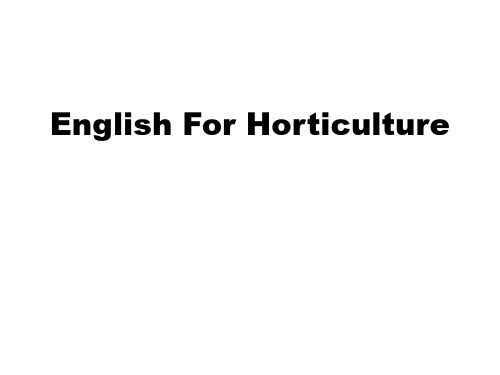
• What are the three major areas of horticulture? • What is the history of horticulture? • Why is horticulture popular?
Why is horticulture a science, a technology, and an industry?
• Ornamental Horticulture- growing and using plants for their beauty inside and outside our homes.
• Food Crop Production- growing crops for use as food.
It also includes maintenance and care of vegetable crops as well commercial and non-traditional vegetable crop production including organic gardening and organic farming; sustainable agriculture and horticulture; hydroponics; and biotechnology.
园林专业英语课程教学大纲

《园林专业英语》课程教学大纲一、课程基本信息课程代码:010235课程名称:园林专业英语英文名称:English for Landscape and Architecture课程类别:专业拓展课学时:36学分:2适用对象: 园林专业考核方式:考查先修课程:大学英语二、课程简介“园林专业英语”是针对园林专业本科学生而开设的一门专业选修课。
通过本课程的学习,要求学生掌握一定数量的专业英语词汇,了解科技文章常见语法表现的一些规律和特点,了解科技论文的文体结构;进一步提高他们阅读专业英语文献的能力,达到能够借助词典等阅读国外最新园林专业英文资料的目的。
该课程的主要内容包括:世界城市发展的历程;园林景观的概念演变;园林设计的要素;园林中所使用的材料;园林质地;园林结构;色彩与装饰;园林形式;园林植物配置;城市重建;城市的扩建;城市的交通;城市文化等。
“English for Landscape Architecture” is an alternative lesson for undergraduates of landscape architecture. After finishing the study, students will be asked to master some important new words, grammar characteristics and context structure of scientific papers. Their abilities of reading English articles will be improved, and it is possible for them to read the latest English papers about gardening and landscape architecture. The following are included: concept evolution of garden, elements of garden design, materials, texture, structure, colour and decoration, form, planting, city regeneration, extending the city, communication and the city, culture and city and so on.三、课程性质与教学目的本课程为园林专业的专业选修课。
《园艺专业英语》教学大纲
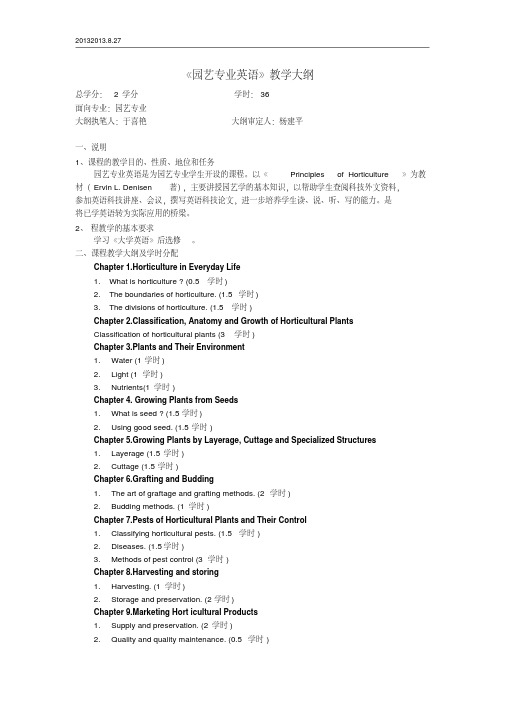
《园艺专业英语》教学大纲总学分: 2学分学时:36面向专业:园艺专业大纲执笔人:于喜艳大纲审定人:杨建平一、说明1、课程的教学目的、性质、地位和任务园艺专业英语是为园艺专业学生开设的课程。
以《Principles of Horticulture》为教材(Ervin L. Denisen 著),主要讲授园艺学的基本知识,以帮助学生查阅科技外文资料,参加英语科技讲座、会议,撰写英语科技论文,进一步培养学生读、说、听、写的能力。
是将已学英语转为实际应用的桥梁。
2、程教学的基本要求学习《大学英语》后选修。
二、课程教学大纲及学时分配Chapter 1.Horticulture in Everyday Life1.What is horticulture ? (0.5 学时)2.The boundaries of horticulture. (1.5学时)3.The divisions of horticulture. (1.5学时)Chapter 2.Classification, Anatomy and Growth of Horticultural PlantsClassification of horticultural plants (3学时)Chapter 3.Plants and Their Environment1.Water (1学时)2.Light (1学时)3.Nutrients(1学时)Chapter 4. Growing Plants from Seeds1.What is seed ? (1.5学时)ing good seed. (1.5学时)Chapter 5.Growing Plants by Layerage, Cuttage and Specialized Structuresyerage (1.5学时)2.Cuttage (1.5学时)Chapter 6.Grafting and Budding1.The art of graftage and grafting methods. (2学时)2.Budding methods. (1学时)Chapter 7.Pests of Horticultural Plants and Their Control1.Classifying horticultural pests. (1.5学时)2.Diseases. (1.5学时)3.Methods of pest control (3学时)Chapter 8.Harvesting and storing1.Harvesting. (1学时)2.Storage and preservation. (2学时)Chapter 9.Marketing Hort icultural Products1.Supply and preservation. (2学时)2.Quality and quality maintenance. (0.5学时)3.What to look for in marketing. (1.5学时)Chapter 10.Improvement of Horticultural Plants by Breeding and Selection1.Genes and herbedity and basic procedures in plant breeding. (1.5学时)2.Selecting parental material. (0.5学时)3.Making crosses and techniques of grossing. (1.5学时)4.Growing seedings and the selection process. (1学时)5.Evaluation program. (0.5学时)6.Philosophies of plant improvement. (1学时)二、课程考核要求闭卷考试。
园艺专业英语(课后翻译)教学文稿

园艺专业英语翻译(中→英)Lesson1 part A1、protected (structure) horticulture is defined as a cultivation method taking use of heat keeping ,chillingprevention or cooling and rainproof facilities to prevent the crops production from being influenced or seriously done by natural seasons and to artificially create a microclimate environment suitable for growing horticultural crops in cold or hot weather hat actually unfavorable to the cropdevelopment .it is also termed as out-of-season culture ,season-off culture or forcing culture .because of the season in which horticultural crops are planted is hand for their growing in open field.2、Windbreak、cold –frame 、hot-frame、plastic-clad tunnel and greenhouse could provide a variety ofvegetable seeding for open field or protected culture or protect seeding of cold tolerant vegetableliving through the winter ,for early planting and acquirement of early mature products.3、In respect of structure type, the largest horticultural structure area in our country consists of plastictunnels and lean to houses, especially the energy-sawing solar greenhouse, which has become thedominant greenhouse type in the country. Presently the development of large greenhouse ormulti-span house has been initiated.Lesson2 part A4、In horticultural crop cultivation under structure the key point of environment management for growersis to create optimal complex of environmental conditions for crop growth and development, aspossibly as they can, according to properties and environmental demand of crop.Lesson3 part ALesson4 part A1、most soil amendments are consisted of the increasing of organic matters ,addition of specific nutritionalelements and ph adjustment2、the soil is an important constitute of the land loamy soil must consist of soul particles with properratio ,with equilibrium of nutrients ,in which contains some organic matter ,and with considerablemoistureLesson5 part ALesson6 part A1、sink demand of horticultural crops extremely affects photosynthetic ,for example ,leaf photosynthesisnoticeably decrease when potato tubers are removed during their growth short-term response may be stomato close effect ,but this cannot explain common continuous effects ,sometime when thesource-sink ratio increases significantly ,some old leaves can renew their photosynthesisfunctions ,on the other hand ,rapidly growing sinks sometimes compete with leaves for mobilizable nitrogen and this results in abscission of leaves and lower photosynthesis capacity.2、It is not clear yet that how the sink demand affect photosynthesis of leaves .the simplest explanation isthat photosynthesis accumulated in leaves restrain photosynthesis . however trials for examining this hypothesis usually obtained the opposite results .furthermore ,in practice ,photosynthates seemly notaccumulate beside chloroplasts in mesophyll cells .thus ,more research work should be done onsource-sink relationship to improve yields of horticultural cropsLesson7 part A1、the development of horticultural crops product organs consist of maturity 、full ripeness and senescencestages .maturity includes physiological ripeness and horticultural ripeness the former means that in the last growth stage ,mature organs become full ripening and the later means the best growth stage of horticultural crops for harvest ,such as leaf vegetables ,when they are reaped ,they are notphysiological ripe ,and flower crops are harvested when thy flower.Full ripeness is the develop stage after fruit mature some fruits can get full ripeness in trees ,whilesome must ripen after separated from trees .after full ripen the flesh mealiness aroma strength proper acidity and sugar ,senescence is a stopping terminating process of living activity. In this stage,product organs quality of horticultural crops become bad and completely leaves their economicalvalue in the endLesson8 part A1、hormone produced by seed influence fruit setting ,fruit growth and the balance of hormones in plant2、Stone fruits can no t set their fruits when their embryos develop abnormally. pome fruits can set withoutseeds ,but flesh cells grow slowly3、Gibberellins was produced after pollination with seed development gibberellins promotes synthesis ofauxin , therefore ,promotes fruit setting .the fruit set and fruit growth is similar between the ovule not pollinated treated by gibberellins and those which has seed4、Gibberellins produced by apple seeds apparently restrain flower differentiation and result in alternatefruiting .alternate fruiting is not normal in pear and many stone fruits .it is because the earlyoccurrence of gibberellins synthesis peak which is not concurrent with flower differentiationinitiation.Lesson13 part A1、pruning of fruit trees is a practice involves the heading back cuts and the thinning cuts of branches forgood framework ,for regulating contradiction between growth and fruiting ,for maintaining theequilibrium between vegetative growth and propagative growth and for good sunlight exposure, to fruit early to achieve high yield and to get commodity with high quality2、the pruning methods are best determined by the characteristics of fruit species and cultivars ,the climatethe soil condition and the crop developing stages and growth status .in order to get the best result ,it is useful to combine pruning with other cultural practices like fertilization ,irrigation, etc3、Reinvigoration of trees is better performed annually, which can keep fruit from stimulating excessivesprouts .remove dead branches, sprouts and some crossing shoots. Secondly, large branches should be thinned out gradually to open tree chamber and to improve distribution of sunlight in order tosimulate fruiting.Lesson15 part A1、temperature is an critical element in biological ,chemical and physiological processes of all plant species2、Temperature regulates the rate of chemical reactions ,leading to the adjustment of plant growth rate.3、As a important contributing factor to climate .temperature play an important role in adaptability andgrowth ,date of plant thus the horticultural crop types which can be cultured in a specific area rely on temperature4、Most plants can live and grow in the range of 0 to 50℃ .however low-temperature sensitivity limit thesuccessful cultivated regions of plantsLesson16 part A1、sprinkler irrigation is often used in maintaining and flower beds which has the specialty the uniformwater amount in its coverage .however, water waste occur when sprinkler is not limited in the area need irrigation .in addition ,evaporation result in some water loss too。
《风景园林专业外语》教学大纲

《风景园林专业外语》教学大纲一、基本信息二、教学目标及任务使园林专业的高年级学生通过专业英语的学习,了解国外园林发展动态,学习吸收国外的先进理论。
要求学生熟练掌握专业术语的翻译方法以及专业词汇的运用;熟悉专业英语文体的特点,能够阅读翻译英文文献资料,以及进行中文资料的英文翻译。
三、学时分配四、教学内容及教学要求第一单元对风景园林学的认识Insight into Landscape Architecture本单元习题要点:风景园林的释义,风景园林学产生的背景和过程,风景园林师的职业和责任,东西方传统与现代风景园林的比较,翻译。
本单元重点、难点:重点为风景园林的释义及风景园林学科的产生,难点为“风景园林”学科名称在每个国家和地区的不同叫法,以及内涵上的差异。
本单元教学要求:结合中国的发展,讲解风景园林的概念、学科情况和职业情况。
讲解翻译的基本方法与技巧,专业术语的翻译方法。
第二单元中国传统园林China traditional garden本单元习题要点:中国传统园林的发展过程,中国传统园林的特点,中国古典名园名称的翻译,中国传统造园要素、造园方法相关术语的翻译。
本单元重点、难点:重点为中国传统园林的基本知识,难点为与中国传统园林相关术语的翻译。
本单元教学要求:汇总中国传统园林相关的专业词汇,使学生能够准确地将有关中国传统园林的文字翻译成英文。
第三单元西方传统园林Western traditional garde本单元习题要点:西方传统园林的发展过程及特点,西方传统不同时期园林风格和传统名园名称的翻译,包括古代的罗马、希腊、埃及、两河流域的园林,中世纪的修道院园林、城堡园林和伊斯兰园林,文艺复兴的意大利和法国园林。
本单元重点、难点:重点为西方传统园林的基本知识,难点为与西方传统园林相关的术语的翻译。
本单元教学要求:汇总西方传统园林相关的专业词汇,使学生能够准确地将有关西方传统园林的文字翻译成中文。
第四单元英国的自然风景园landscape garden of England本单元习题要点:英国自然风景园的产生背景、特点、设计师及代表作,自然风景园对近代风景园林尤其是城市公园的的影响。
园艺专业英语:Lesson 3 Plants and Environmental Factors

• Root hairs- single cell roots
located a few mm back from root tip, absorb water
• Root cap- mass of cells that
– Stigma- sticky surface for capturing pollen at top of styles
– Style- tube-like structure that connects stigma and ovary
– Ovary- contains ovules or eggs
protects root tips from coarse soil
What are the differences between taproot and fibrous root systems?
• Taproot
– One large primary root that grows down + small secondary roots
• Whitish or tan in color • Make up one-half or more of the entire plant body • Absorb water and nutrients from the soil then transport
them above ground • Serve to anchor and support the top portion on plant • Can store carbohydrates to be used later for energy by
《园艺专业英语》课程教学大纲

《园艺专业英语》课程教学大纲课程名称:园艺专业英语课程类别:专业选修课适用专业:园艺考核方式:考查总学时、学分:32学时2学分其中实验学时:学时一、课程教学目的园艺专业英语是为园艺专业学生开设的选修课程,主要讲授园艺学英语的基本知识,旨在帮助学生提高阅读英文专业资料的能力,并具备查阅英文专业资料的能力。
通过本课程学习,学生可参加英语科技讲座、会议,撰写简单英语科技论文,以培养高素质的、符合国际化标准的人才,使学生毕业后能很快适应社会的要求,能够进行国际交流与合作,参与国际竞争。
二、课程教学要求1.可阅读理解园艺专业英文文献及资料;2.掌握基本园艺学知识的英文口头、书面表达。
三、先修课程大学英语及园艺学专业课程。
四、课程教学重、难点重点:阅读并理解园艺专业英文文献资料。
难点:翻译及撰写英语科技论文。
五、课程教学方法与教学手段本课程主要以专业英文文献为基础,利用多媒体课件,听力材料等手段,扩大视野,增大信息量。
课堂讲授和讨论相结合。
通过阅读讲解教材章节、专题讨论外文文献等方式掌握该学科的发展动态。
六、课程教学内容注:专业英语选取教材的部分章节讲授,可根据学生具体情况略作调整。
Lesson 1 The History and the Development of Protected Cultivation(2学时)1.教学内容(1) Reading Materials:The History and the Development of Protected Cultivation(2) Early Development and Status of Plasticulture2.重、难点提示(1) Protected cropping(2) Structure of GreenhousesLesson 2 Soil Properties of Horticultural Crop Cultivation(2学时)1.教学内容(1) Orchard Soil Management and Deciduous Fruit Tree Nutrition(2) Plant-growing Media2.重、难点提示(1) Soil Properties;(2) Plant-growing Media;Lesson 3 Soilless Cultivation(2学时)1.教学内容(1) Reading Material:Soilless Culture(2) Soilless Culture Technique2.重、难点提示(1) Re-circulated hydroponics system(2) Nutrient-film technique (NFT) 营养液膜技术;Lesson 4 Drip Irrigation Technology(2学时)1.教学内容(1) Reading Material:Drip Irrigation Technology(2) NMSU Scientist Studies Latest Drip Irrigation Technology 2.重、难点提示(1) Drip irrigation(2) Precision agricultureLesson 5 Plasticulture(2学时)1.教学内容(1) Reading Material:Plasticulture(2) The Future of Plasticulture: Challenges and Opportunities 2.重、难点提示(1) Plasticulture(2) Controlled environment agricultureLesson 6 Biotechnology and Horticulture(2学时)1.教学内容(1) Haploids and Anther Culture(2) Gene Transfer2.重、难点提示(1) What is biotechnology?(2) Gene TransferLesson 7 Crop Production Situation(2学时)1.教学内容(1) Reading Material:Crop Production Situation(2) CO2 Enrichment in Practice2.重、难点提示(1) Production situation 1 — potential yield as defined by CO2, radiation and temperature(2) Production situation 2a — attainable yield as limited by water(3) Production situation 2b — attainable yields as limited by nutrients(4) Production situation 3 — actual yields as reduced by effects of weeds, pests, diseases and pollutantsLesson 8 Dry Matter Production and Distribution(2学时)1.教学内容(1) Reading Material: Dry Matter Production and Distribution(2) The Growth and Yield Responses of strawberry to Elevated CO2 and N Supply 2.重、难点提示(1) Carbohydrates produced by photosynthesis(2) The breakdown of carbohydrates to yield energy for growth and cell activities.Lesson 9 Plant Biological Control and Natural Pollination(2学时)1.教学内容(1) Reading Material: Plant Biological Control and Natural Pollination(2) Insect Biology and Ecology: A Primer2.重、难点提示(1) Natural Pollination(2) Plant Biological ControlLesson 10 Plant Disease(2学时)1.教学内容(1) Reading Material: Plant Disease(2) Chemical Control in Integrated Pest Management (IPM)2.重、难点提示(1) Plant Disease(2) Integrated Pest ManagementLesson 11 Quality and Harvest of Horticultural Products(2学时)1.教学内容(1) Hand Harvesting of Fruit Crops(2) Postharvest Handling of Nine Specialty Cut Flower Species2.重、难点提示(1) Quality of Horticultural Produce(2) Harvesting of Horticultural ProduceLesson 12 Greenhouse Tomatoes(2学时)1.教学内容(1) Reading Material: Greenhouse Tomatoes(2) Botany of Tomato2.重、难点提示(1) Scheduling the Crop(2) Pest ManagementLesson 13 Pruning Fruit Trees(2学时)1.教学内容(1) Reading Material: Pruning Fruit Trees(2) The Jujube Fruit2.重、难点提示(1) Central leader system(2) Open-center systemLesson 14 Assortment of Ornamental Crops(2学时)1.教学内容(1) Reading Material: Assortment of Ornamental Crops(2) Static flowers and dynamic flowers2.重、难点提示(1) Cut flowers and pot plants(2) The main factors determining the quality of ornamental crops Lesson 15 Propagation of Horticultural Crops(2学时)1.教学内容(1) Reading Material: Propagation of Horticultural Crops(2) Selection Programmes in China2.重、难点提示(1) Propagation of Horticultural Crops(2) Kiwifruit Breeding Programmes in New ZealandLesson 16 Writing A Research Report(2学时)1.教学内容(1) Reading Material: Writing A Research Report(2)The Application of Tables and Figures on Writing a Scientific Paper 2.重、难点提示(1) Layout of a research report(2) Tenses of verbs七、学时分配八、课程考核方式1.考核方式笔试;开卷。
幼儿园中班英语教案园艺与植物英语园艺与植物单元教学教案

幼儿园中班英语教案-《园艺与植物》:英语园艺与植物单元教学教案幼儿园中班英语教案-《园艺与植物》:英语园艺与植物单元教学教案本教案旨在帮助幼儿园中班的孩子们学习关于园艺和植物的英语知识,提高他们的英语听说读写能力。
该教案将通过多种教学方法和实践活动来教授英语知识,让孩子们在愉悦的氛围中学习成长。
教学目标:1. 学习和掌握与园艺和植物相关的英语单词和词组。
2. 听懂、说出简单的关于园艺和植物的英语句子。
3. 了解植物的基本结构和生长环境。
4. 通过实践活动提高孩子们对植物的兴趣,培养他们的观察能力和动手能力。
教学内容:1. 词汇学习:根、叶、花、果、土壤、阳光、水、种子等。
2. 句型学习:This is a leaf. These are flowers. The root is in the soil. The sun gives the plant energy. The plant needs water to grow. We can plant seeds in the soil.3. 实践活动:观察不同的植物,分辨它们的根、叶、花和果实。
种植小花盆,体验种植过程,观察花的生长过程,记录生长变化。
教学步骤:第一步:导入通过展示不同的植物图片和视频,激发孩子们对植物的兴趣,引导他们发表自己对植物的看法和感受。
第二步:词汇学习介绍植物的基本部分和生长环境,通过图片和实物展示教授单词和词组,让孩子们学会正确地说出这些词汇。
老师可以采用多种方式,如演示、游戏等来巩固孩子们的词汇记忆。
第三步:句型学习通过展示图片和实物,让孩子们感性理解句子的意思,然后引导孩子们试着模仿老师的发音,尝试说出这些句子。
老师可以采用唱歌、游戏等活动来巩固孩子们的句型记忆。
第四步:实践活动带领孩子们观察不同的植物,并指导他们分辨植物的不同部分,如根、叶、花和果实。
然后,老师可以和孩子们一起种植小花盆,让孩子们亲身体验种植的过程,观察植物的生长过程,并记录下植物生长变化。
《园林专业英语》课程大纲
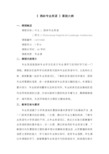
《园林专业英语》课程大纲一、课程概述课程名称(中文):园林专业英语(英文):Professional English for Landscape Architecture 课程编号:14351068课程学分:3学分课程总学时:48学时课程性质:专业课二、课程内容简介专业英语是园林专业学生在进行专业课学习的同时学习的一门课程。
课程旨在指导学生阅读有关园林专业的英语书刊、文选和论文等,使其掌握一定的专业英语词汇、了解科技英语的写作格式,获取专业所需要的信息,进一步提高阅读专业英语文献的能力。
本课程主要内容为:专业阅读和翻译以及科技写作。
专业阅读完成由基础阶段向应用性阅读的过渡,内容以园林方面的科技专著为主,兼顾植物保护、城市规划、生态学等相关方面的文献选读等。
三、教学目标与要求专业英语基于大学英语和风景园林基本原理学习的基础开设,是一门具有双重目的的课程。
一方面,通过对专业文章的阅读,了解专业英语与大学英语的不同,从专业英语词汇、表达方式等方面掌握专业英语阅读的基本能力;另一方面,通过所选用的专业英语文章,了解国内外风景园林方面的基本理论和最新发展动态,从而掌握阅读英语原文资料的能力,学习相关专业理论知识、拓宽专业视野。
学生通过本课程的学习,能够掌握专业英语书刊的阅读技巧,阅读国外相关的专业文献;了解文献检索的知识和方法,以掌握国内外本专业发展前沿的最新动态;培养用英语进行学术交流和具备一定的科技英语写作的能力。
四、教学内容与学时安排绪论(2学时)1. 教学目的与要求:了解专业英语的特点,掌握一些翻译技巧以及前后缀的使用。
了解园林专业的英语称谓的变化。
2. 教学重点与难点:前后缀的使用及意义Unit 1 What is landscape architectue (4学时)1. 教学目的与要求:学习以美国为主的北美景观设计发展历史,了解现代景观设计实践中不同的研究领域。
展开景观设计师职业的英语讨论。
《园林专业英语》教学大纲
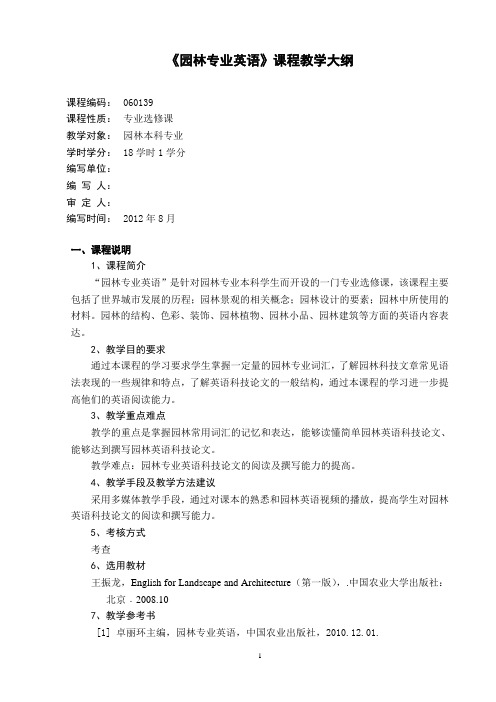
《园林专业英语》课程教学大纲课程编码:060139课程性质:专业选修课教学对象:园林本科专业学时学分:18学时1学分编写单位:编写人:审定人:编写时间:2012年8月一、课程说明1、课程简介“园林专业英语”是针对园林专业本科学生而开设的一门专业选修课,该课程主要包括了世界城市发展的历程;园林景观的相关概念;园林设计的要素;园林中所使用的材料。
园林的结构、色彩、装饰、园林植物、园林小品、园林建筑等方面的英语内容表达。
2、教学目的要求通过本课程的学习要求学生掌握一定量的园林专业词汇,了解园林科技文章常见语法表现的一些规律和特点,了解英语科技论文的一般结构,通过本课程的学习进一步提高他们的英语阅读能力。
3、教学重点难点教学的重点是掌握园林常用词汇的记忆和表达,能够读懂简单园林英语科技论文、能够达到撰写园林英语科技论文。
教学难点:园林专业英语科技论文的阅读及撰写能力的提高。
4、教学手段及教学方法建议采用多媒体教学手段,通过对课本的熟悉和园林英语视频的播放,提高学生对园林英语科技论文的阅读和撰写能力。
5、考核方式考查6、选用教材王振龙,English for Landscape and Architecture(第一版),.中国农业大学出版社:北京﹒2008.107、教学参考书[1] 卓丽环主编,园林专业英语,中国农业出版社,2010.12.01.[2] 史静静,于显威.园林专业英语,化学工业出版社,2008.09.01[3]王欣,方薇.景观设计(风景园林)专业英语,水利水电出版社,2008.09.01[4]蔡君等编园林专业——高等学校专业英语系列教材,中国建筑工业出版社,2005.02.01[5]王玉翠主编.每天读点中国文化·自然景观,大连理工大学出版社,2010.05.01二、教学内容第一章Introduction(2学时)1、教学目标(1).了解城市的发展历程;(2).了解世界各国在城市化进程中所面临的主要问题;(3).城市建筑如何与城市的风格统一;(4).掌握有关城市化以及建筑等方面的专业词汇。
园艺专业外语课件
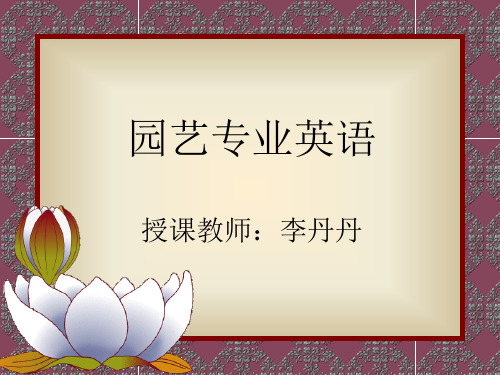
塑料不仅可用于温室透明覆盖,也可以取代无土栽培 种植床的水泥硬化地面,或做成塑料袋填装无土基质, 进行无土栽培生产。 Plastics not only can be used as glazing cover of greenhouse, can also in place of the concrete in lining the growing beds , or be made to be plastic bag for packing growing media to soilless cultureuality improvement through climate control is the recently developed concept of DIF temperature.
气候控制不能看成是与作物相隔离的,因为温室气 候控制就是要试图创造作物理想的生长条件。 Climate control cannot be seen as separate from the crop, for which one tries to create optimal conditions.
塑料覆盖栽培也被称作第二次绿色革命,因为它已经 使世界范围内几乎所有的国家都显著提高了其粮食产 量。 As the Green Revolution expanded the production of agronomic crops, Plasticulture has provided yet another revolution. While more silent, plasticulture has enabled countries throughout the world to greatly extend their food production capability.
《 园艺专业英语》课程教学大纲
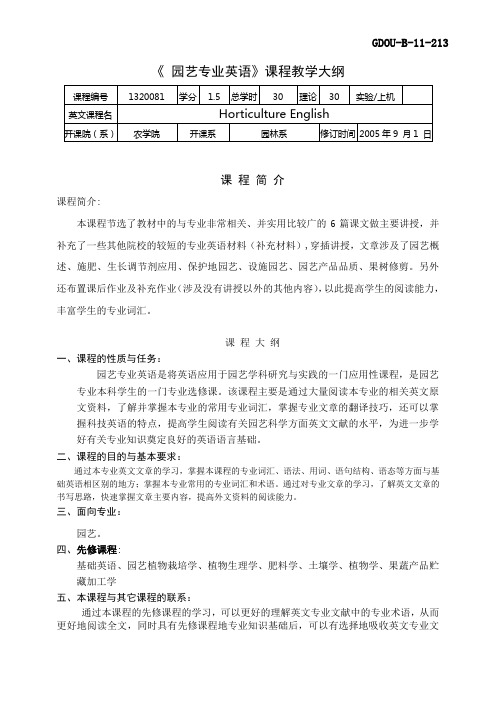
GDOU-B-11-213《园艺专业英语》课程教学大纲课程简介课程简介:本课程节选了教材中的与专业非常相关、并实用比较广的6篇课文做主要讲授,并补充了一些其他院校的较短的专业英语材料(补充材料),穿插讲授,文章涉及了园艺概述、施肥、生长调节剂应用、保护地园艺、设施园艺、园艺产品品质、果树修剪。
另外还布置课后作业及补充作业(涉及没有讲授以外的其他内容),以此提高学生的阅读能力,丰富学生的专业词汇。
课程大纲一、课程的性质与任务:园艺专业英语是将英语应用于园艺学科研究与实践的一门应用性课程,是园艺专业本科学生的一门专业选修课。
该课程主要是通过大量阅读本专业的相关英文原文资料,了解并掌握本专业的常用专业词汇,掌握专业文章的翻译技巧,还可以掌握科技英语的特点,提高学生阅读有关园艺科学方面英文文献的水平,为进一步学好有关专业知识奠定良好的英语语言基础。
二、课程的目的与基本要求:通过本专业英文文章的学习,掌握本课程的专业词汇、语法、用词、语句结构、语态等方面与基础英语相区别的地方;掌握本专业常用的专业词汇和术语。
通过对专业文章的学习,了解英文文章的书写思路,快速掌握文章主要内容,提高外文资料的阅读能力。
三、面向专业:园艺。
四、先修课程:基础英语、园艺植物栽培学、植物生理学、肥料学、土壤学、植物学、果蔬产品贮藏加工学五、本课程与其它课程的联系:通过本课程的先修课程的学习,可以更好的理解英文专业文献中的专业术语,从而更好地阅读全文,同时具有先修课程地专业知识基础后,可以有选择地吸收英文专业文献中地不同观点和经验。
本课程可以为以后地毕业论文查阅读英文文献,书写论文英文摘要打下基础。
六、教学内容安排、要求、学时分配及作业:本课程的讲授内容为节选自教材部分文章,以及补充外校的英文材料。
按照课时数和文章具体内容和学生接受程度进行课时分配和讲解。
Lesson 1 The History and the Development of Protected Cultivation(4学时)布置课文后汉译英作业补充材料1(2学时)布置补充材料英译汉翻译作业Lesson 2 Goals of Greenhouse Climate Control(2学时)布置课文后汉译英作业补充材料2(1学时)布置补充材料英译汉翻译作业讲解作业(0.3学时)Lesson7 Plasticulture(3学时)布置课文后汉译英作业补充材料3(1学时)布置补充材料英译汉翻译作业Lesson 13 Quality and Harvest of Horticulture Products(4学时)补充材料4(1学时)布置补充材料英译汉翻译作业Lesson 15 flower differentiation, pollination and fruit set(3学时)讲解作业(0.3学时)Lesson 16 Greenhouse Tomatoes(4学时)布置课文后汉译英作业补充材料5(1学时)Lesson 17 Pruning Fruit Trees(3学时)布置课文后汉译英作业讲解作业(0.4学时)七、教材与参考书:本课程选用教材:全国高等农业院校教材:《园艺专业英语》,李亚灵主编,中国农业出版社出版。
园艺专业英语第二版课文
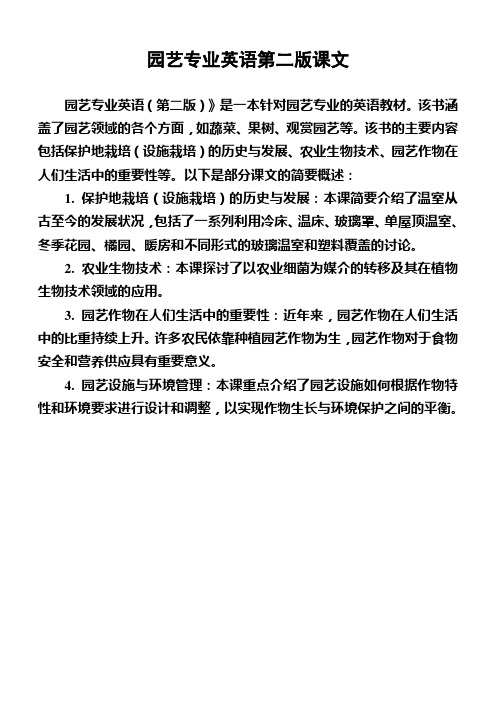
园艺专业英语第二版课文
园艺专业英语(第二版)》是一本针对园艺专业的英语教材。
该书涵盖了园艺领域的各个方面,如蔬菜、果树、观赏园艺等。
该书的主要内容包括保护地栽培(设施栽培)的历史与发展、农业生物技术、园艺作物在人们生活中的重要性等。
以下是部分课文的简要概述:
1. 保护地栽培(设施栽培)的历史与发展:本课简要介绍了温室从古至今的发展状况,包括了一系列利用冷床、温床、玻璃罩、单屋顶温室、冬季花园、橘园、暖房和不同形式的玻璃温室和塑料覆盖的讨论。
2. 农业生物技术:本课探讨了以农业细菌为媒介的转移及其在植物生物技术领域的应用。
3. 园艺作物在人们生活中的重要性:近年来,园艺作物在人们生活中的比重持续上升。
许多农民依靠种植园艺作物为生,园艺作物对于食物安全和营养供应具有重要意义。
4. 园艺设施与环境管理:本课重点介绍了园艺设施如何根据作物特性和环境要求进行设计和调整,以实现作物生长与环境保护之间的平衡。
- 1、下载文档前请自行甄别文档内容的完整性,平台不提供额外的编辑、内容补充、找答案等附加服务。
- 2、"仅部分预览"的文档,不可在线预览部分如存在完整性等问题,可反馈申请退款(可完整预览的文档不适用该条件!)。
- 3、如文档侵犯您的权益,请联系客服反馈,我们会尽快为您处理(人工客服工作时间:9:00-18:30)。
GDOU-B-11-213《园艺专业英语》课程教学大纲
课程简介
课程简介:
本课程节选了教材中的与专业非常相关、并实用比较广的6篇课文做主要讲授,并补充了一些其他院校的较短的专业英语材料(补充材料),穿插讲授,文章涉及了园艺概述、施肥、生长调节剂应用、保护地园艺、设施园艺、园艺产品品质、果树修剪。
另外还布置课后作业及补充作业(涉及没有讲授以外的其他内容),以此提高学生的阅读能力,丰富学生的专业词汇。
课程大纲
一、课程的性质与任务:
园艺专业英语是将英语应用于园艺学科研究与实践的一门应用性课程,是园艺专业本科学生的一门专业选修课。
该课程主要是通过大量阅读本专业的相关英文原文资料,了解并掌握本专业的常用专业词汇,掌握专业文章的翻译技巧,还可以掌握科技英语的特点,提高学生阅读有关园艺科学方面英文文献的水平,为进一步学好有关专业知识奠定良好的英语语言基础。
二、课程的目的与基本要求:
通过本专业英文文章的学习,掌握本课程的专业词汇、语法、用词、语句结构、语态等方面与基础英语相区别的地方;掌握本专业常用的专业词汇和术语。
通过对专业文章的学习,了解英文文章的书写思路,快速掌握文章主要内容,提高外文资料的阅读能力。
三、面向专业:
园艺。
四、先修课程:
基础英语、园艺植物栽培学、植物生理学、肥料学、土壤学、植物学、果蔬产品贮藏加工学
五、本课程与其它课程的联系:
通过本课程的先修课程的学习,可以更好的理解英文专业文献中的专业术语,从而更好地阅读全文,同时具有先修课程地专业知识基础后,可以有选择地吸收英文专业文献中地不同观点和经验。
本课程可以为以后地毕业论文查阅读英文文献,书写论文英文摘要打下基础。
六、教学内容安排、要求、学时分配及作业:
本课程的讲授内容为节选自教材部分文章,以及补充外校的英文材料。
按照课时数和文章具体内容和学生接受程度进行课时分配和讲解。
Lesson 1 The History and the Development of Protected Cultivation(4学时)布置课文后汉译英作业
补充材料1(2学时)
布置补充材料英译汉翻译作业
Lesson 2 Goals of Greenhouse Climate Control(2学时)
布置课文后汉译英作业
补充材料2(1学时)
布置补充材料英译汉翻译作业
讲解作业(0.3学时)
Lesson7 Plasticulture(3学时)
布置课文后汉译英作业
补充材料3(1学时)
布置补充材料英译汉翻译作业
Lesson 13 Quality and Harvest of Horticulture Products(4学时)
补充材料4(1学时)
布置补充材料英译汉翻译作业
Lesson 15 flower differentiation, pollination and fruit set(3学时)
讲解作业(0.3学时)
Lesson 16 Greenhouse Tomatoes(4学时)
布置课文后汉译英作业
补充材料5(1学时)
Lesson 17 Pruning Fruit Trees(3学时)
布置课文后汉译英作业
讲解作业(0.4学时)
七、教材与参考书:
本课程选用教材:
全国高等农业院校教材:《园艺专业英语》,李亚灵主编,中国农业出版社出版。
2003
本课程推荐参考书:
《农林英语》,教育部《农林英语》教材编写组编,高等教育出版社,北京,2001。
《生物专业英语》,蒋悟生主编,高等教育出版社,2000年
《园艺英语》车代弟、王晓为主编,哈尔滨工程大学出版社,2003年
八、本课程理论课及实验课的考核方式:
理论课考核方式:闭卷考试70%,作业+平时30%
执笔:
审核:
批准人:
时间:。
